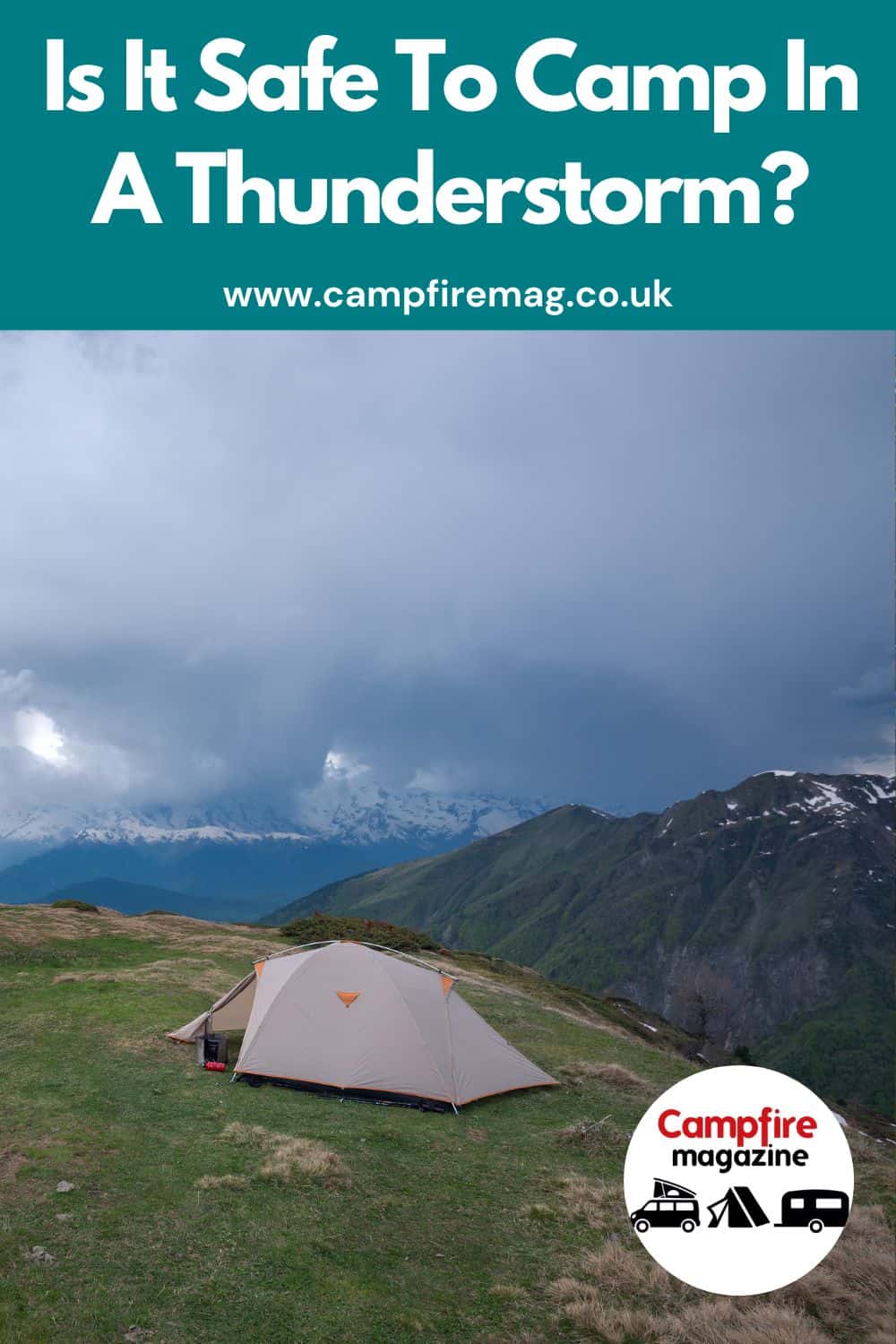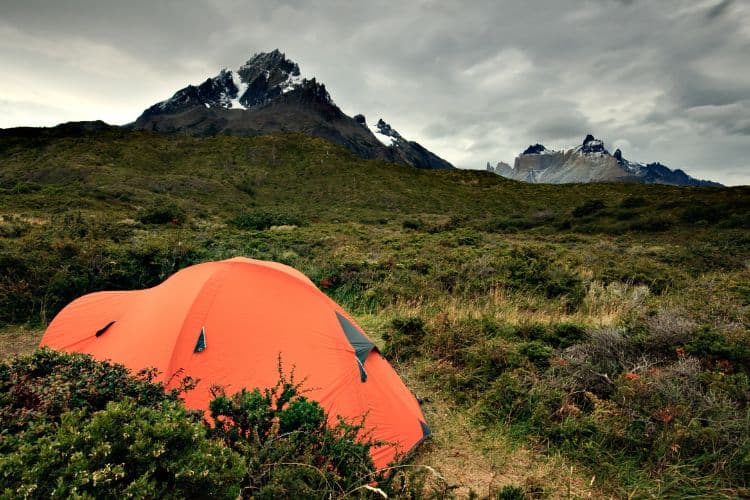Is It Safe To Camp In A Thunderstorm?
Staying safe is one of the most important things when it comes to camping. There are lots of situations that you may find yourself in and, when camping in the UK, the weather could put you in a tricky spot.

While thunderstorms aren’t all that common here, we do experience the odd one or two, especially during the summer. What’s more, there’s a lot of suggestion that they’ll become more common in this country as the effects of global warming take hold.
So, if you find yourself camping and the weather takes a turn for the worst, you’ll probably be wondering, is it safe to camp in a thunderstorm?
While we wouldn’t recommend purposefully scheduling your camping trip when there’s a chance of thunder, if you find yourself in a storm, you’re not in any immediate danger. In fact, it’s said that you’re more likely to win the lottery than you are to be struck by lightning.
If those are the odds, then there’s really not too much to worry about. I mean, I’m yet to win big on the Lotto so I’m not about to panic about getting hit by lightning.
With that in mind, you shouldn’t become blase about camping in a thunderstorm because naturally, there are risks involved. Being prepared and ensuring you have the right gear will make your experience much more comfortable and safe.
What Are The Risks Of Camping In A Thunderstorm?
One of the most obvious risks of camping in a thunderstorm is being hit by lightning. However, as I have mentioned, the chances of this are slim. Although it can and does happen and the best way to avoid it is to protect yourself but I’ll explain more about that later on.
For now, I wanted to touch on some of the less obvious issues you might face when you camp in a thunderstorm. For example, falling tree branches are not uncommon and if one of these hits your tent then you stand to be seriously injured or even killed! For this reason, it’s a good idea never to pitch your tent under a tree that has weak, dead or rotting branches.
Secondly, you have to consider that, in a very rough storm, your tent could blow away. Now this is extreme and perhaps like something out of the Wizard of Oz but it does happen so make sure you buy a sturdy tent that’s well anchored into the ground.
Finally, there is the issue of exposure to the cold and wet. If you end up getting soaked in a storm and all of your gear is wet then there’s a real risk of hypothermia. To avoid this, make sure to use waterproof backpacks and if you do find yourself drenched, change out of your wet clothing as soon as possible.
How Do I Stay Safe When Camping In A Thunderstorm?
Avoiding camping in a thunderstorm isn’t always possible especially when the storm comes out of nowhere. However, there are things you can do to keep safe and every wise camper will remember these tips for that one time they get caught in the eye of the storm!
Choose The Right Place To Pitch Your Tent
A lot of people worry that their tent poles will attract lightning however this is a common misconception. Most modern tents have poles made from either carbon fibre or plastic, neither of which are very strong conductors so you’ll be pretty safe. That said, if you have an older tent with aluminium poles then this could attract lightning.
The thing with lightning is that it will always find the fastest route to the ground. By ensuring that your tent isn’t the highest object within the vicinity, this boosts your safety enormously.
That said, the last thing you want to do is to place your tent directly under a taller object such as a tree. Should this be hit, the flash or any resulting fire may be enough to injure you inside your tent.
The best place to pitch your tent is somewhere low-lying. Of course, you’ll need to make sure that you’re not camping in an area that’s at risk of flooding so do your research on the area before you go.
Suspecting A Storm
Sometimes a storm will come out of nowhere but there are often signs to show that one is on the way. Things like dark skies, puffy clouds, winds, a change in pressure and temperature changes can all signal a storm. Some people even just get ‘that feeling.’
If you do feel that a storm is imminent then there are some things you can do to improve your chances of staying safe. For example, if you have time, you can move your tent to a safer spot. You’ll probably also want to put on appropriate clothing and pack any gear away into waterproof bags to protect it should any water get into the tent.
While it might be beautiful and sunny one minute, the weather can change incredibly quickly. To avoid getting caught out, it’s always a good idea to plan your trip with every eventuality in mind.
Find Alternative Shelter Where Possible
Your tent might serve as a shelter in most cases but it’s not really designed to protect you against a storm. Where possible, you should seek out alternative shelter while the thunderstorm rages on.
Make sure that, if you are going to seek alternative shelter, that you do this before the storm comes in. If you have to access the shelter by opening a door with a metal handle, for example, this isn’t something you’ll want to do when there is lightning about.
You can remain in the shelter for as long as you wish but I would suggest staying until you can no longer hear the storm.
Depending on where you are, your options for alternative shelter may vary. Your car is a good place, provided it isn’t a convertible. While cars do contain a lot of metal, if they’re struck by lightning, this will only travel around the outer part and won’t affect anyone inside.
Some areas may have small buildings nearby. If you’re at a campsite then heading to the shower block or toilets can be a great way to shelter from the storm.
Of course, there are some structures that aren’t as suitable for taking shelter. These include things like outhouses or gazebos. So avoid these and if they’re all that’s available then take your chances in the tent.
But if your tent does have poles that will act as conductors then it certainly isn’t the best place for you. In this instance, you’re going to have to think outside the box. Come out of the tent and move to a safe location that isn’t on a ridge or under any trees. You might have to look for a depression or cave to shelter from the rain until it passes.
With all that in mind, most modern tents are pretty safe in a storm and they’ll keep you dry. This is especially true when they’re placed in a low risk location.

Keep Off The Ground
It might surprise you to learn that a lot of lightning injuries don’t happen from a direct strike but are actually the result of the ground conducting the bolt. What’s even more disconcerting is that this conduction can happen as far as 10 metres from the site of the strike. For this reason, it makes sense to keep yourself off of the ground.
Never lie directly on it but instead use a sleeping mat made from an insulating material like foam. It might not offer complete protection but should a bolt hit, you’ll be far better off than you would be if you were directly on the ground.
Don’t Huddle In Large Groups
A lot of people go camping with their friends and families and this often requires the use of several tents. However, it’s not a good idea to place them all very close together when a storm is involved.
In the event that lightning hits and the tents are not spread out, there’s more chance that more people will get hurt. If you distance the tents from each other, it’ll be safer for the majority and any injured people can be treated by those that are unaffected.
Lightning can jump between people that are close to one another and this isn’t a risk you’ll want to take.
Enjoy Nature At Its Best
All of this can sound pretty scary but one thing that we have to keep in mind is that a thunderstorm is one of nature’s most beautiful events. As long as you are safe then there’s no reason you can’t sit back and watch this glorious weather taking place.
The sound of the wind howling, rain lashing against the tent and the rumble of thunder are among some of the most relaxing and wonderful sounds in nature. Again, I have to stress that you should put safety first but don’t miss the opportunity to enjoy nature at its best.
Conclusion
Camping in a thunderstorm does come with risks but there are plenty of ways you can keep yourself safe. Most modern tents don’t have poles that conduct electricity so it’s unlikely that you’ll be hit.
That said, location is everything so always make sure to avoid camping on high ground or underneath structures such as trees.
In many cases, it’ll be fine to stay in your tent but there may be some extreme situations that call for the need to evacuate. Use your common sense and trust your gut. If you don’t feel safe, do something about it.







